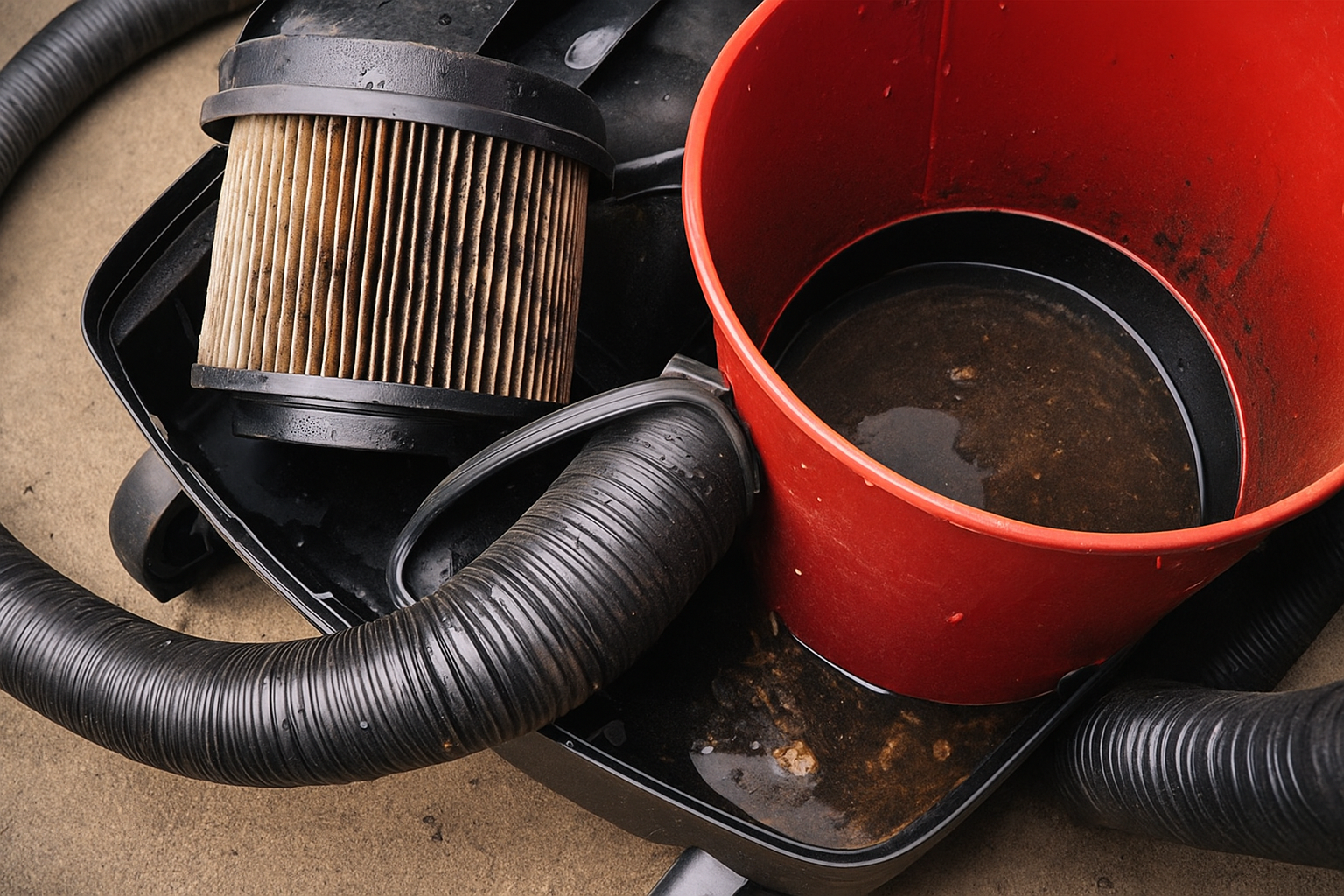“If your vacuum greets you with a musty odor, it’s telling you that biology has entered your cleaning tool.”
Wet-dry vacuums promise versatility: they collect spilled liquids, fine dust, and heavy debris in one sweep.
Yet many users notice an unpleasant smell after the machine sits idle for a week.
The cause is rarely mysterious—it’s a mixture of moisture, organic residue, and insufficient airflow trapped inside a sealed system.
To make vacuums last longer and stay hygienic, both engineers and users must understand how odor forms and how design can prevent it.
🧫 1. Moisture: the Hidden Enemy
When a wet-dry vacuum finishes its job, a small volume of water almost always remains in the collection tank, hose, or filter area.
That leftover moisture forms a perfect habitat for bacteria, mildew, and mold.
Because these microbes feed on organic dust, hair, and detergent residues, the interior becomes a low-oxygen, warm environment—ideal for growth.
A simple formula explains the smell:
Humidity + Residue + Time = Odor
Even a few milliliters of water left near the filter or foam gasket can create a sour, earthy scent within 48 hours.
⚙️ 2. Engineering Design and Airflow
True odor prevention starts at the drawing board. Smart airflow and drainage reduce the chance that water will linger.
🔄 a. Sloped Drain Geometry
A 5- to 10-degree tank slope ensures complete emptying. Flat bottoms allow stagnant puddles that breed microbes.
🌬️ b. Separate Cooling and Suction Air
In reliable wet and dry vacuum cleaner designs, the cooling air never passes through dirty moisture.
This prevents damp exhaust foam from becoming a bacterial sponge.
🔩 c. Non-absorbent Materials
Closed-cell EVA or polyurethane hoses and silicone gaskets resist water absorption and dry quickly.
Open-cell foams, by contrast, trap humidity like a sponge.
🔋 d. Post-Run Dry Cycle
Some advanced models briefly keep the motor running after the water collection stops.
This “self-drying phase” pushes warm air through ducts, evaporating residual droplets.
Design decisions like these distinguish a durable wet and dry vacuum cleaner from one that turns into a portable compost bin.
🧼 3. User Habits that Invite Odor
Even the best machine will smell if it’s stored wet.
The most common mistakes include:
Closing the lid immediately after cleaning. Moisture gets sealed inside.
Neglecting filter care. A damp HEPA filter vacuum cleaner can grow mold within days.
Leaving dirty water overnight. The mixture of dust, detergent, and pet hair decays quickly.
Storing in humid garages. External moisture adds to internal condensation.
Regular rinsing and air-drying turn odor control from frustration into routine maintenance.
🌡️ 4. Drying and Storage Best Practices
Rinse the tank with warm water and mild detergent. Avoid harsh chemicals that damage seals.
Detach the hose and accessories so internal air can circulate.
Run the motor for two minutes without water collection to expel moisture.
Air-dry filters in indirect sunlight; never use heat sources that warp plastics.
Store with the lid open to allow ventilation.
Proper drying not only removes smell but also prevents corrosion on metal components and electrical contacts.
🔬 5. Maintenance and After-Sales Implications
From a product-management viewpoint, odor complaints are not just customer-service issues—they signal incomplete drying design or unclear maintenance instructions.
For distributors and technicians, documenting these cases helps identify recurring structural flaws such as:
Poor tank slope or drainage port design
Incompatible foam materials
Filters placed too close to the exhaust zone
By improving these weak points, manufacturers reduce after-sales returns and extend the service life of wet dry vacuum cleaners.
✨ 6. The Science of Freshness
Clean air inside a vacuum depends on three disciplines working together:
Fluid dynamics — ensuring smooth airflow and minimal condensation.
Material science — selecting hydrophobic polymers and antimicrobial coatings.
User ergonomics — making cleaning and drying intuitive, not tedious.
Reliability and hygiene are inseparable. A vacuum that stays fresh also stays functional.
“Dry inside, clean outside—that’s the real measure of a vacuum’s design.”
🧩 Conclusion
Wet-dry vacuums represent one of the most versatile cleaning tools ever made—but that versatility demands care.
When moisture, airflow, and material design work together, the system stays fresh and dependable.
Most odor problems can be prevented not by expensive replacements, but by thoughtful design and consistent maintenance.
Keeping a vacuum clean is not just about hygiene; it’s a reflection of engineering discipline.
A machine that stays dry inside will always deliver stronger suction, longer service life, and better user satisfaction.
“The difference between a smelly vacuum and a reliable one is only five minutes of drying time.”
🔗 Explore More
Want to learn more about airflow design, hygiene engineering, and long-life vacuum systems?
Visit our Vacuum Technology Knowledge Hub www.lxvacuum.com for in-depth articles and technical resources about suction design, noise control, and reliability engineering.
📊 SEO TAG
wet and dry vacuum cleaner, vacuum odor, vacuum smell prevention, odor control vacuum, vacuum drying, moisture removal, vacuum maintenance, wet vacuum storage, cleaning equipment hygiene, HEPA filter vacuum, filter drying, antimicrobial vacuum, air flow design, vacuum drainage system, mold prevention vacuum, mildew smell, odor free vacuum cleaner, durable wet dry vacuum, vacuum tank design, vacuum maintenance tips, moisture resistant vacuum, water collection vacuum, cleaning machine maintenance, vacuum hygiene, vacuum storage guide, wet dry vacuum maintenance, filter cleaning, vacuum smell after use, anti bacterial vacuum, smart drying system, self cleaning vacuum, odorless vacuum, vacuum cleaning performance, air circulation vacuum, efficient drying vacuum, household vacuum hygiene, industrial wet vacuum, filter replacement, vacuum ventilation, vacuum cleaning tips, home cleaning appliance, quiet wet vacuum, eco cleaning equipment, odor resistant vacuum, long life vacuum, durable materials, sustainable design, smart home vacuum, hygiene engineering, cleaning innovation, vacuum performance reliability.

















